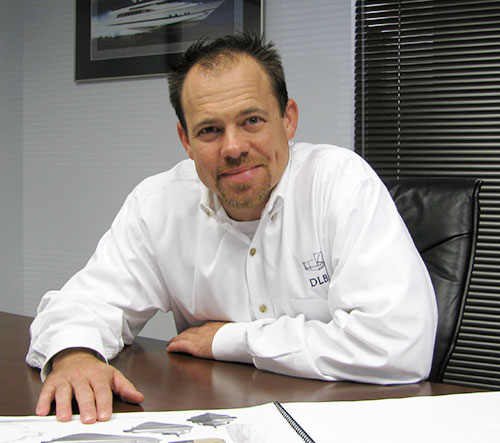DLBA UNIVERSITY
An Investigation into the Effects of Waterjet Tunnels on the Resistance, Trim, and Dynamic Lift of a Planing Monohull
JULY 26, 2019
By Jeffrey B. Bowles
This paper examines the effects of waterjet tunnels on the performance of a high-speed planning hull. The parent model of the series 62 Systematic Planing Hull Series was constructed and tested with three different configurations: bare-hull, appended hull with short waterjets tunnels, and appended hull with long waterjets tunnels. Values of resistance, CG Rise, and dynamic trim were recorded and compared between three configurations. The test results for the bare-hull correspond very well with the Series 62test results.

The effects of the waterjet tunnels on the bare-hull performance differ from one test condition to another, but in general they have higher values for resistance, trim, and CG Rise. Waterjet Tunnel B is a better performer than Waterjet Tunnel A, indicating that the opening of the waterjet inlet duct should be located further from the transom rather than closer. Finally, the model testing tank at the University of Newcastle is not the best facility for testing high-speed craft due to limited model size and carriage speed. Also, the acquisition of data for quantitative measurements is difficult because of shallow water effects that are inherent with the shallow tank depths.
In case you would like to receive more information or discuss about this subject, please contact Jeffrey Bowles.
References
1. Alexander, K. and van Terwisga, T, (1993) “Recent Work on Waterjet-Hull Interaction,” 9thHigh Speed Craft Conference, Singapore, Vol. 1, pg. 1-22.
2. Allison, John, (1993) “Marine Waterjet Propulsion,” SNAME Transactions, New Jersey, Vol. 101, pr. 275-335.
3. Blount, D.L., (1994) “Achievements with Advanced Craft,” NavalEngineers Journal, September, pg. 49-59.
4. Blount, D.L. (2001) Donald L. Blount and Associates, Inc. Various phone and e-mail correspondences.
5. Bowles, J.B. (2000) The Comparative Performance of Screw Propellers vs. Waterjets when Driving a Sportfisherman, Thesis, Webb Institute, New York.
6. Clement, E.P., and Blount, D.L., (1963) “Resistance Tests of a Systematic Series of Planing Hull Forms,” SNAME Transactions, New York, Vol. 71, pg. 491-579.
7. Contender, (2001) Contender Sportfishing Boats [Online] Available: www.contender.com
8. Coop, H.G., and Bowen, A.J., (1993) “Hull-Waterjet Interaction mechanisms: Theory and Validation,” Proceedings of the Second International Conference on Fast Sea Transportation, Tokyo, Vol. 74, pg. 561-610.
9. Hadler, J., (1966) “The Prediction of Power performance on Planing Craft.” SNAME Transactions, New York, Vol. 74, pg. 563-610
10. Hamilton Jet (2000) Miscellaneous manufacturer’s brochures.
11. Hamilton Jet (2001) Hamilton Jet–Pioneers of Waterjet Propulsion [Online]. Available: www.hamjet.co.nz.
12. ITTC, (1987) “Report of the High Speed Marine Vehicle Committee, International Towing Tank Conference 1987, pg. 304-307.
13. KaMeWa (2000) Miscellaneous manufacturer’s brochures.
14. MacPherson, D.M. (1999) “A Universal Parametric Model for Waterjet Performance,” FAST 1999, Proceedings of the Fifth International Conference on Fast Sea Transportation, Seattle, pg. 96-104.
15. Ridgley-Nevitt, C., (1956) “The resistance of Trawler Hull Forms of 0.65 Prismatic Coefficient,” SNAME Transactions, New York, Vol. 64, pg. 433-468.
16. Savitsky, D. and Ross, E., (1952) “Turbulence Stimulation in the Boundary Layer of Planing Surfaces, Part II,” Stephens Institute of Technology, New Jersey, Report 444, pg. 21-32. van Manen, J.D. and van Oossanen, P., (1988) “Resistance,” Principles of Naval Architecture, Vol. ii –Resistance, propulsion, and Vibration, The Society of Naval Architects and marine Engineers, Editor: Lewis, E., New Jersey, pg. 3-15, 53-66, 99-105.
17. van Terwisga, T., (1993) “A Theoretical Model for the Powering Characteristics of Waterjet-Hull Systems,” FAST 93, Proceedings of the Second International Conference on Fast Sea Transportation, Tokyo, Vol II, pg. 975-992.
18. van Terwisga, T., (1977) “A Parametric propulsion Prediction method for waterjet Driven Craft,” FAST 97, proceedings of the Fourth International Conference on Fast Sea Transportation, Sydney, Vol. II, pg. 661-667.
19. Werenskiold, P., (2001) Marintek, Various e-mail correspondences.
Share this article online:
HOW CAN WE HELP YOU?
FEEL FREE TO CONTACT US

DLBA Naval Architects
860 Greenbrier Circle, Suite 201 Chesapeake, Virginia 23320 USA
Phone: 757-545-3700 | Fax: 757-545-8227 | dlba@gibbscox.com
STAY UPDATED
SIGN UP FOR OUR NEWSLETTER
Keep your finger on the pulse of the latest points of focus in naval architecture and engineering: subscribe to DLBA’s concise monthly newsletter. Within it, we briefly describe and picture our latest projects and concepts. We encourage feedback and seek to have our newsletter spark conversation regarding potential collaborations and further advancements as we share our passion for the industry.
